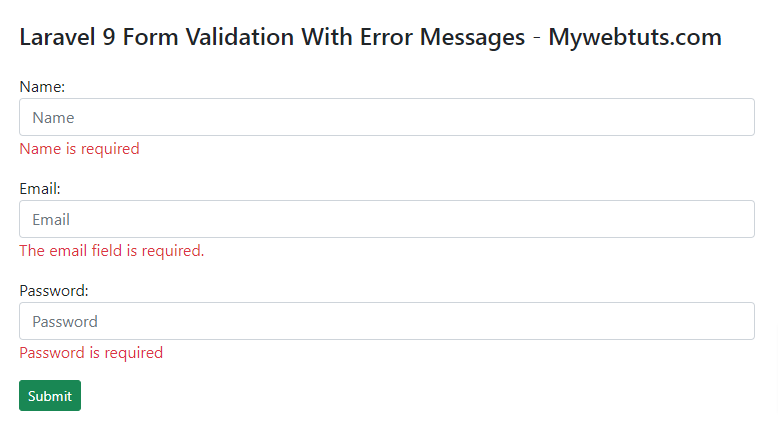Laravel 9 Form Validation With Error Messages
Feb 09, 2022 . Admin

Hi Friends,
This article goes in detailed on laravel 9 form validation with error messages. We will look at example of laravel 9 form validation with error message text. if you have question about form validation laravel 9 then i will give simple example with solution.
You can also define laravel 9 form validation custom error messages. we will display error message with each field. we will use laravel 9 form request custom validation.
Here, i am going to show you very simple example of form validation so, you can simply use in your laravel 9 project.
Step 1: Download LaravelLet us begin the tutorial by installing a new laravel application. if you have already created the project, then skip following step.
composer create-project laravel/laravel example-appStep 2: Create Routes routes/web.php
<?php
use Illuminate\Support\Facades\Route;
use App\Http\Controllers\StudentController;
/*
|--------------------------------------------------------------------------
| Web Routes
|--------------------------------------------------------------------------
|
| Here is where you can register web routes for your application. These
| routes are loaded by the RouteServiceProvider within a group which
| contains the "web" middleware group. Now create something great!
|
*/
Route::get('student/create',[StudentController::class,'create']);
Route::post('student/store',[StudentController::class,'store'])->name('student.store');
Step 3: Create Controller
Now we will add two controller method, one will just display blade file with get request, and another for post request, i write validation for that, so simply add both following method on it.
app/Http/Controllers/StudentController.php
<?php
namespace App\Http\Controllers;
use Illuminate\Http\Request;
use App\Models\Student;
class StudentController extends Controller
{
/**
* Show the application dashboard.
*
* @return \Illuminate\Http\Response
*/
public function create()
{
return view('createStudent');
}
/**
* Show the application dashboard.
*
* @return \Illuminate\Http\Response
*/
public function store(Request $request)
{
$validatedData = $request->validate([
'name' => 'required',
'password' => 'required|min:5',
'email' => 'required|email|unique:users'
], [
'name.required' => 'Name is required',
'password.required' => 'Password is required'
]);
$validatedData['password'] = bcrypt($validatedData['password']);
$user = Student::create($validatedData);
return back()->with('success', 'Student created successfully.');
}
}
Step 4: Create Blade File
now here we will create createUser.blade.php file and here we will create bootstrap simple form with error validation message. So, let's create following file:
resources/views/createStudent.blade.php
<!DOCTYPE html>
<html>
<head>
<title>Laravel 9 Form Validation With Error Messages - Mywebtuts.com</title>
<meta charset="utf-8">
<meta http-equiv="X-UA-Compatible" content="IE=edge">
<meta name="viewport" content="width=device-width, initial-scale=1">
<link href="https://cdn.jsdelivr.net/npm/bootstrap@5.1.3/dist/css/bootstrap.min.css" rel="stylesheet">
</head>
<body>
<div class="container">
<div class="row justify-content-center mt-5">
<div class="col-md-8 mt-5">
<h3>Laravel 9 Form Validation With Error Messages - Mywebtuts.com</h3>
@if(Session::has('success'))
<div class="alert alert-success">
{{ Session::get('success') }}
@php
Session::forget('success');
@endphp
</div>
@endif
<form method="post" action="{{ route('student.store') }}" class="mt-4">
{{ csrf_field() }}
<div class="form-group mb-3">
<label>Name:</label>
<input type="text" name="name" class="form-control" placeholder="Name">
@if ($errors->has('name'))
<span class="text-danger">{{ $errors->first('name') }}</span>
@endif
</div>
<div class="form-group mb-3">
<label>Email:</label>
<input type="text" name="email" class="form-control" placeholder="Email">
@if ($errors->has('email'))
<span class="text-danger">{{ $errors->first('email') }}</span>
@endif
</div>
<div class="form-group mb-3">
<label>Password:</label>
<input type="password" name="password" class="form-control" placeholder="Password">
@if ($errors->has('password'))
<span class="text-danger">{{ $errors->first('password') }}</span>
@endif
</div>
<div class="form-group">
<button class="btn btn-success btn-submit btn-sm">Submit</button>
</div>
</form>
</div>
</div>
</div>
</body>
</html>
Run Laravel App:
All steps have been done, now you have to type the given command and hit enter to run the laravel app:
php artisan serve
Now, you have to open web browser, type the given URL and view the app output:
http://localhost:8000/student/createOutput :

I hope it can help you...
